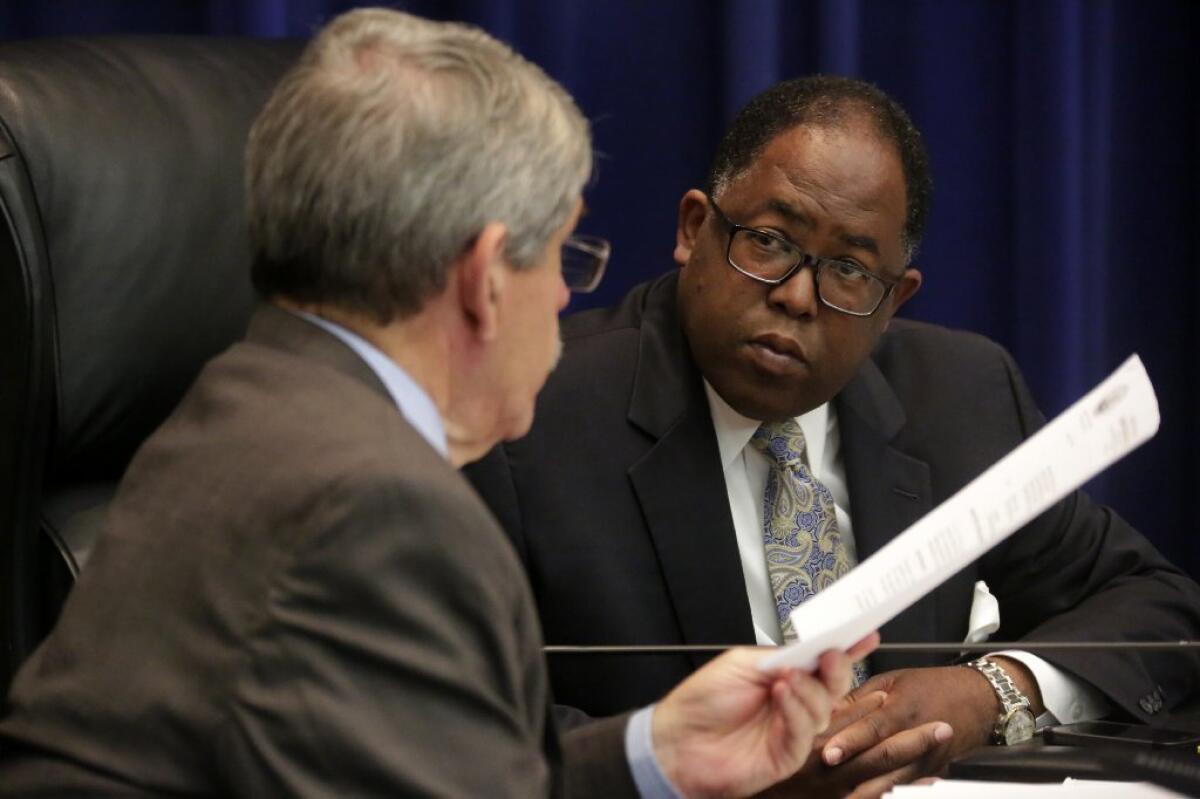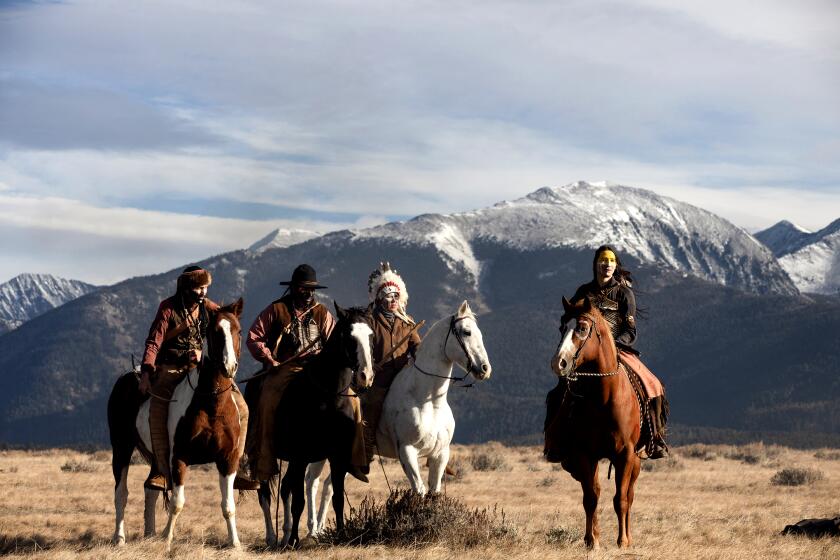Mark Ridley-Thomas pushes planned $8-million Culver City arts center

- Share via
With Gloria Molina and Zev Yaroslavsky, the members of the Los Angeles County Board of Supervisors who’ve been most active in pushing for government funding for cultural venues, about to step down due to term limits, board holdover Mark Ridley-Thomas is getting into the arts-venue creation game.
Ridley-Thomas is the prime mover behind an $8-million plan to convert a county-owned former courthouse in Culver City into a cultural center that he envisions including a possible outpost of the Los Angeles County Museum of Art and a media-arts education hub supported by Sony Pictures Entertainment.
Ridley-Thomas’ bid to headline the creation of a cultural facility is on a more modest scale than such big-ticket projects as Hollywood Bowl renovations, championed by Yaroslavsky, and the creation of La Plaza de Cultura y Artes and Grand Park, projects driven by Molina in downtown L.A.
His plan came to light recently when the Board of Supervisors approved $6 million for what’s tentatively called the 2nd District Arts and Cultural Center in Culver City, which is part of Ridley-Thomas’ 2nd Supervisorial District.
The appropriation “gives us a substantial amount of the funds to move it forward,” with hopes for reopening the 30,000-square-foot, single-story building in its new incarnation by 2016, said Karly Katona, a deputy to Ridley-Thomas who is working on the arts center.
Katona said the building’s overhaul may require some additional funding, with current estimates ranging up to $8 million. The specific uses haven’t been determined yet, she said, but “we’re working with LACMA and Sony and other arts organizations to come up with a final program” before starting design work on renovations.
One potentially sensitive question that will have to be worked out is what’s to become of the Mayme A. Clayton Library and Museum, the repository for a major private collection of books, historical documents and artifacts pertaining to the African American experience.
It has occupied part of the former courthouse since 2006. The county offered the quarters when the materials Clayton had amassed were in danger of suffering wear and tear in a garage behind her Los Angeles home.
The Clayton Library and Museum’s interests won’t be ignored, Katona said. “We’re committed to working with the [Clayton] foundation to make sure they have a long-term sustainable and appropriate home, whether it’s in the Culver City Arts Center or an alternative location.”
Lloyd Clayton, executive director of the museum foundation, said he didn’t want to comment until he’d had a chance to talk to Ridley-Thomas about plans for the building.
“I wouldn’t say it’s a surprise,” he said of the plan.
LACMA director Michael Govan said that the art museum hasn’t committed to a satellite gallery in Culver City, although it would serve a strategic goal of establishing outposts around the county to make LACMA’s collection and programs easily accessible to a wider public.
“Nothing’s firm, it’s super-preliminary,” Govan said of his talks with Ridley-Thomas’s office. But he said the former courthouse made a good impression when he visited it. “It’s an interesting place, a beautiful mid-century building with a courtyard that’s closed in. It needs a little TLC.”
Govan noted that the Culver City site promises to be the rare arts facility that includes a courtroom and a holding cell, which had been occupied by criminal defendants who’d been transported from the county jail for their court dates.
Since 2007, LACMA has presented about one exhibition per year at one satellite location, Charles White Elementary School in MacArthur Park. The Los Angeles Unified School District campus has a 3,000-square-foot art gallery, a holdover from the school’s past incarnation as the the home of Otis Art Institute (now Otis College of Art and Design).
LACMA is trying to secure funding for a separate entrance and a full-time curator/educator, which Govan said would allow the gallery to be a standalone that could operate beyond “extremely limited” viewing hours that currently must harmonize with the school’s regular operations. Only about 2,000 people a year see the art shows.
“You’re not going to see the precious masterpieces”; in a satellite gallery because of security and climate issues, Govan said, “;but there is a lot in our collection that has few constraints and can travel to quite a few places.”;
Another use Ridley-Thomas envisions for the Culver City center is an “arts incubator” program in which small nonprofit arts groups would be given free or subsidized use of space at the arts center for up to three years, along with management assistance from the Los Angeles County Arts Commission -- all aimed at strengthening them for future independence.
Strategically, said Katona, the supervisor’s aide, the arts center aims to give another push to arts-driven development in downtown Culver City that began in the early 2000s and so far has been spearheaded by the city government rather than the county.
“The supervisor has always recognized the emerging arts that have grown in Culver City, and wanted to be sure the county brought to bear the resources we could to complement the mini-renaissance that’s happened in the area,” Katona said. The courthouse building is less than a mile south of downtown Culver City’s arts and entertainment district.
Investing mainly through its now-defunct Community Redevelopment Agency, the city of Culver City provided the two theater buildings that mark off either end of the six-block-long district along West Washington Boulevard and Culver Boulevard -- Center Theatre Group’s 315-seat Kirk Douglas Theatre in a refurbished old-time movie palace near City Hall, and the Actor’s Gang’s 99-seat stage at the Ivy Substation, a 1907-vintage former power generating station for the Los Angeles Pacific Railway Company.
The city also has set aside a parcel next to the Douglas as a site for the Jazz Bakery, a now-itinerant nonprofit producer of jazz concerts that aims to build a jazz club and is raising funds privately.
Until now, Ridley-Thomas’ most public arts advocacy effort was securing county funding to sustain a summer arts internship program that was endangered when federal funding ended after the recession. The internships match college students who come from L.A. County with nonprofit arts organizations, paying them $4,000 each for a 10-week job immersing them in how arts organizations operate. Katona said that the Culver City arts center could include a centralized office for the internship program, which is administered by the county arts commission.
Follow @boehmm of the LA Times for arts news and features
More to Read
The biggest entertainment stories
Get our big stories about Hollywood, film, television, music, arts, culture and more right in your inbox as soon as they publish.
You may occasionally receive promotional content from the Los Angeles Times.











